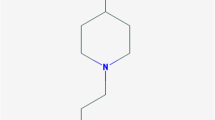Abstract
Neurophysiologic disorders developed in three patients after discontinuation of transdermal fentanyl (TDF) at a daily dose of 0.6 mg (2.5 mg per a patch), although direct removal of a 2.5 mg patch is permitted by the manufacturer as the formulation has the lowest fentanyl content among all the commercially available patch formulations. These observations indicate that the discontinuation of TDF carries a risk for developing withdrawal symptoms even when using a 2.5 mg patch. To avoid such adverse events, we considered the necessity of gradual reduction in the daily fentanyl requirements. For this purpose, we covered part of the application surface of the patch with an insulating tape, and then increased the covered area in a stepwise manner. There were no apparent withdrawal signs during the procedure described above.
Similar content being viewed by others
References
CA Kornick J Santiago-Palma N Moryl R Payne EA Obbens (2003) ArticleTitleBenefit-risk assessment of transdermal fentanyl for the treatment of chronic pain. Drug Saf 26 951–73 Occurrence Handle1:CAS:528:DC%2BD3sXptF2kurc%3D Occurrence Handle14583070
KA Lehmann D Zech (1992) ArticleTitleTransdermal fentanyl: clinical pharmacology. J Pain Symptom Manage 7 (S3) 8–16 Occurrence Handle10.1016/0885-3924(92)90048-M
Product Information, Janssen Pharmaceutical KK, Tokyo, Japan.
CA Naranjo U Busto EM Sellers P Sandor I Ruiz EA Roberts et al. (1981) ArticleTitleA method for estimating the probability of adverse drug reactions. Clin Pharmacol Ther 30 239–45 Occurrence Handle1:CAS:528:DyaL3MXltVygsLk%3D Occurrence Handle7249508
HW Matthes R Maldonado F Simonin O Valverde S Slowe I Kitchen et al. (1996) ArticleTitleLoss of morphine-induced analgesia, reward effect and withdrawal symptoms in mice lacking the μ-opioid-receptor gene. Nature 383 819–23 Occurrence Handle10.1038/383819a0 Occurrence Handle1:CAS:528:DyaK28Xms1Sjtbw%3D Occurrence Handle8893006
JG Bovill (1987) ArticleTitleWhich potent opioid? Important criteria for selection Drugs 33 520–30 Occurrence Handle1:CAS:528:DyaL2sXksFWiu7k%3D Occurrence Handle2954811
Donner B, Zenz M, Tryba M, Strumpf M. Direct conversion from oral morphine to transdermal fentanyl: a multicenter study in patients with cancer pain. Pain 64: 1996; 527–34.
Matoba M. The recipe of cancer pain management [in Japanese]. Tokyo: Shunjusha, 2004. ISBN 4-393-71048-7.
Author information
Authors and Affiliations
Corresponding author
Rights and permissions
About this article
Cite this article
Ishihara, C., Konishi, H., Chiba, M. et al. Withdrawal symptom after discontinuation of transdermal fentanyl at a daily dose of 0.6 mg. Pharm World Sci 27, 13–15 (2005). https://doi.org/10.1007/s11096-004-2271-7
Issue Date:
DOI: https://doi.org/10.1007/s11096-004-2271-7




